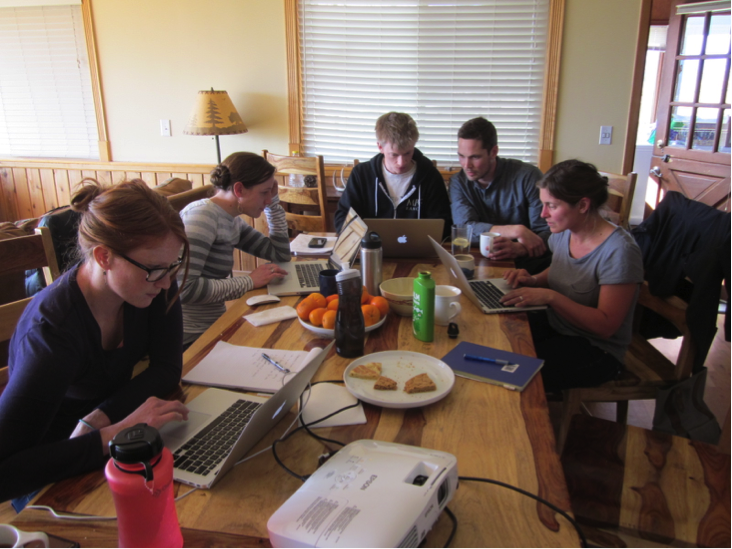
The Tale of a Million Sequences
Block title
 By: Ylva LekbergPh.D. Ecologist
By: Ylva LekbergPh.D. EcologistWith their discovery of DNA, Watson and Crick started the field of molecular genetics in the 1950s. The subsequent development of polymerase chain reaction, or PCR, by Kary Mullis in the 1980s allowed us to amplify and sequence specific regions of DNA for gene analyses and species identification. Perhaps no other field has benefitted more from this than soil ecology. Sequencing has allowed us to identify many of the bacteria and fungi that cannot be grown in culture and has opened our eyes to the stunning biodiversity belowground.
The rapid development of new sequencing techniques is baffling. One hundred sequences from Sanger sequencing used to be what studies were based upon. One could look at each sequence and manually edit where mistakes had been made. Now, with the development of Next Generation Sequencing, we can obtain 20 million sequences from a plate as small as a microscope slide. Amazing. This requires a whole new set of skills, including computer programming and bioinformatics. To ensure that MPG Ranch takes advantage of these new, cutting edge technologies, we invited Cameron Egan from University of British Columbia to come down to help us. Cameron ran an excellent workshop where we learned how to process 4 million sequences from our very first MiSeq run. From these sequences, we hope to learn how arbuscular mycorrhizal fungi and other fungi change along a fertility gradient and with knapweed invasions. We will also find out if soil bacterial communities change in response to severe acidification. As soon as we make sense of it, we will make sure to share our findings!

Lorinda, Alexii, Mike, Cameron and Lauren were busy coding and problem solving during the workshop.

About the AuthorYlva Lekberg
Ylva graduated from the Swedish University of Agricultural Sciences with a M.Sc. in Biology and Horticulture in 1996 and a Ph.D. in Ecology from Penn State University in 2004. She received the Alumni Association Dissertation Award for her work in agroecology and subsistence farming in Sub-Saharan Africa. Post-doctoral positions at Montana State University and later at Copenhagen University as a Marie Curie Fellow allowed her to explore the role of arbuscular mycorrhiza, a root-fungus symbiosis, for geothermal plants in Yellowstone National Park and coastal grasslands in Denmark. Her research has been published in international journals such as Nature Communications, Ecology Letters, and New Phytologist.
Ylva joined MPG Ranch in 2010. Since then, she has explored how invasive plants common to western Montana, including spotted knapweed (Centaurea stoebe), leafy spurge (Euphorbia esula) and cheatgrass (Bromus tectorum), influence soil microbial community composition and function, and how this in turn may affect invasive success. A lot of her research also focuses on the AM symbiosis in terms of community ecology and physiology. A current project addresses how exchange ratios in this symbiosis may differ among co-occurring plants and depend on soil nutrient availabilities. She uses surveys, field and greenhouse experiments, and literature approaches such as meta-analyses to address questions. To learn more about research and publications from Ylva and her group, see CV below and the Soils, Plants and Invasion section.
In addition to her work at MPG Ranch, Ylva is an adjunct professor at University of Montana at the Department of Ecosystem and Conservation Sciences.
Ylva joined MPG Ranch in 2010. Since then, she has explored how invasive plants common to western Montana, including spotted knapweed (Centaurea stoebe), leafy spurge (Euphorbia esula) and cheatgrass (Bromus tectorum), influence soil microbial community composition and function, and how this in turn may affect invasive success. A lot of her research also focuses on the AM symbiosis in terms of community ecology and physiology. A current project addresses how exchange ratios in this symbiosis may differ among co-occurring plants and depend on soil nutrient availabilities. She uses surveys, field and greenhouse experiments, and literature approaches such as meta-analyses to address questions. To learn more about research and publications from Ylva and her group, see CV below and the Soils, Plants and Invasion section.
In addition to her work at MPG Ranch, Ylva is an adjunct professor at University of Montana at the Department of Ecosystem and Conservation Sciences.



















